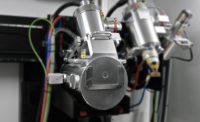Resonance for material analysis. I know, you’re wondering, “What is this guy thinking?” Material analysis has always lived in the Met Lab and tensile strength has always been determined through good old fashioned destructive testing. So, how does resonance fit in? Well, Resonance Ultrasound Spectroscopy, or RUS, is an application of resonance testing that is being used by many of the world’s premier material analysis labs and universities, but it is something that hasn’t really reached commercial laboratories as of yet.
Imagine if you could nondestructively determine the material constants, such as Young’s Modulus, Shear Modulus, Bulk Modulus, and even the Poisson’s ratio of a material sample by simply collecting the natural frequencies. What if it was possible to accurately predict the tensile strength of a dog-bone specimen without ever needing to actually destructively test it? The time savings alone is something to think about, but what else would this testing provide?
You could make material changes to castings, forgings, and even metal injection alloys and then within minutes, know what those changes have done to your yield strength. Not just theoretical guesses, but a direct measurement that incorporates any processing and quality issues, and provides a reliable result.
This is not many years down the road. This is now and these measurements have been tested, validated and proven.
In a 2011 article I wrote for Quality, I stated the following, “The relationship between acoustic or ultrasonic resonance frequencies and material properties has been studied for years in the scientific community. As technological innovations have become available, this study of resonance frequencies has continued. Throughout the years several significant studies and experiments have determined that ultrasonic resonant measurements can be directly correlated to material elastic properties, for a variety of material geometries.” At the time, I knew of several studies that were completed, but I was not able to reference these due to confidentiality. Well, there have been a few studies since then and specifically one related to using RUS to predict yield strength in Metal Injected Material, or MIM. In that study, it was determined that “Correlation analysis results showed that the total variation in 0.2% proof stress that can be attributed to resonant frequencies was above 95% for MIM tensile specimens.” [1]
The RUS technique uses a contact piezoelectric transducer to excite a specimen through a range of resonance frequencies and one or more contact piezoelectric transducers to collect the response data. For Material Constants, this data, along with some basic starting references and accurate sample dimensions are analyzed using a piece of proprietary software. It uses the measured frequencies and reference data to derive the constants. The software uses a calculation algorithm based on a Levenburg-Marquardt scheme to minimize the differences between the measured and calculated resonant frequencies. [2] The result is a highly accurate solution that provides all the previously mentioned material constants.
Another nice aspect of RUS is that it can be used at operating temperatures. Several labs have fabricated cooled testing chambers, micro furnaces and custom fixturing to allow for measurements of samples in either cryogenic environments or at actual operating temperatures. This data has proven critical as many destructive testing methods cannot achieve these temperature ranges.
Some of the many applications are validating new alloy properties, confirming the manufacturing consistency of material properties, and estimating the ‘effective modulus’ in fatigued or porous samples. These applications can be performed on samples cut straight from manufactured pieces and not just from specially processed test specimens.
For tensile strength predictions, the resonance frequencies can be collected from actual test samples and after some initial correlation studies where particular resonances are correlated to actual tensile measurements, these frequencies can be used to predict the tensile strength of a sample. This does require some upfront correlation work, but after that is accomplished, then destructive testing is no longer required. For casting and advanced manufacturing companies, this can save enormous amounts of time and money.
The same resonance frequencies that are used for the tensile predictions can also be used for things like validating a new master heat, confirming an alloy conformance, or even just providing a quality conformance validation. All this can be accomplished by using a fairly quick nondestructive test.
So, I started this article by telling you that material analysis has always lived in the Met Lab and tensile strength has always been determined through good old fashioned destructive testing, but with a gradual adoption of new software, maybe that will change.
References
- Correlation of metal injection moulded Ti6Al4V yield strength with resonance frequency (PCRT) measurements A.T. Sidambe a,n, W.L.Choong b, H.G.C.Hamilton c, I.Todd a
- RUSpec Magnaflux R. Nath





